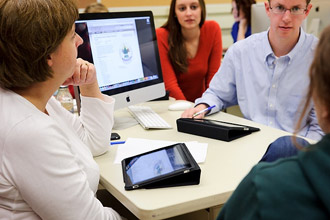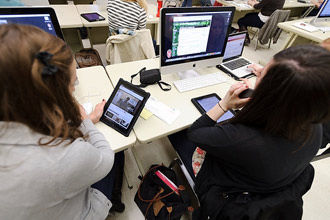Classroom iPad use encourages innovation, reading with ease
The iPad is catching on as a classroom tool at the University of Wisconsin–Madison.

Katy Culver, left, a faculty associate in journalism and mass communication, facilitates an editorial-planning discussion with journalism students in a magazine production class. The class, which uses a combination of iPad tablets, laptop computers and traditional desktop computers, produces Curb Magazine.
Photo: Jeff Miller
The touch-screen tablet has emerged as a way for students to explore new media and serves as an efficient way to do various reading assignments.
Katy Culver, a faculty associate in the School of Journalism and Mass Communication, uses the iPad in her magazine publishing class. Because the magazine industry is struggling to discover how tablets are going to affect readership and advertising, she said the iPad helps her students understand the device’s place in this ever-changing industry.
“Students need to get their hands on a device to understand it and dream up new ways to use it,” Culver says.
The iPad, provided through UW General Library System, has been integrated into her class as a tool to develop editorial and advertising content for the class publication, Curb Magazine.
Culver’s students publish a complete edition of Curb and also produce an app to accompany it. Her goal is to have students understand how this app will affect print magazine production and how the use of audio, video and slideshows enhance the platform.

Journalism students use a combination of iPad tablets, laptop computers and traditional desktop computers during a magazine-production class in Vilas Communication Hall.
Photo: Jeff Miller
At first, Culver said her students expressed sheer excitement about how the iPad was used in the course curriculum. Overall, it has been a positive experience in her class since it has not made significant changes to the syllabus.
Emily Kesner, public relations manager of Curb, sees great benefit in having hands-on experience with this type of technology.
“It’s interesting seeing how content – both print and digital – can combine and be accessible through an iPad,” she says. “As a journalism student working to understand industry trends and how that relates to my future employment, I have found the iPad to be extremely helpful.”
As much of the work in the School of Journalism and Mass Communication is collaborative, Culver also assigns a research project that relates to the impact of tablet devices on the content and business models of magazines.
“Anytime we can take a device and put it into a context where students are engaging with it, understanding how consumers use magazines and how advertisers perceive it, it gives them a richer understanding of the medium,” says Culver.
The School of Business has used the Amazon Kindle and iPad in undergraduate courses, but student feedback on their advantages has been mixed. Doctoral students, however, are participating in a two-year pilot program in the Business Library. Michael Enyart, director of this library, says the program has had great success among these students.
“This has gone over very well,” he says. “We have had very good feedback by our doctoral students on using the iPad compared to the mixed feedback that we received from undergraduates.”
These Ph.D. students seem to enjoy reading on an iPad due to the nature of the volume of academic articles they must read as opposed to a traditional textbook.
The School of Business combines the iPad with additional software so articles in PDF format can be annotated with notes and highlighting as a paper article would.
As the iPad continues to debut in certain areas of campus, Enyart says he looks forward to the challenge that classes face when determining the most effective way to learn with the iPad.
“We have not found a good experiment where we can put textbooks on these iPads yet,” he says. “When we start seeing electronic textbooks that mimic physical books, I see iPads as more readily adapted by students.”
Overall, Enyart and Culver see the iPad as a positive addition to students’ university experience, though they hope to see more textbooks available on the iPad.
“I enjoy reading on the iPad,” says Culver. “However you can’t even get desk copies of textbooks for the iPad in media fields where you would expect people to have the latest technology available.”
Ken Frazier, director of the UW General Library System, says these experiments with new technology have a significant impact on coursework within the university.
“Our early experiments with iPads were useful in uncovering problems with technology and what was wrong in using them in the classroom,” he says. “Recent experiments, however, are reaching a tipping point; they have fixed those earlier problems. Eventually, these devices and e-textbooks will dominate the educational market.”
Both schools are continuing to use the iPad to increase students’ engagement, ultimately increasing their understanding of what they are learning.
“Many people are used to doing things a certain way,” says Culver. “But when we move into a new direction, I am open minded and take advantage of this new technology. Why not?”
